Posted by sydney on Feb 28th, 2009
- 1793: February 28, 1793 – Planted 50 good cabbage-plants: mended the bed planted in autumn, & eaten in part by the hares.
- 1790: February 28, 1790 – Violets abound.
- 1788: February 28, 1788 – Sowed the great mead, & Baker’s Hill with a good dressing of ashes: of my own 31 bushels; bought 54.
- 1786: February 28, 1786 – The snow is at an average about seven inches deep. As it fell without any wind, it is lodged much on the trees, so that the prospects are very grotesque, & picturesque.
- 1783: February 28, 1783 – Rain in Feb: 5 in. 54 hun. Peter Wells’s well ceases to run over. It is only 36 feet in depth, & continues almost full all the winter in wet seasons. A lavant from the hanger fills it. The wells in this part of the street are 63 feet deep.
- 1779: February 28, 1779 – Gossamer abound. Frogs swarm in the ditches.
- 1775: February 28, 1775 – Spiders shoot their webs from clod to clod.
- 1774: February 28, 1774 – Much wheat rotted on the ground in the clays.
- 1771: February 28, 1771 – Blackbird whistles. Helleborus viridis emerges, & shows it’s flower budds. Bror Henry’s field opposite his house. was fallowed for barley before the two frosts, all save the headlands: mem: to enquire if the earlier fallowing in that part proved of any advantage.
- 1769: February 28, 1769 – Raven sits.
- 1768: February 28, 1768 – Wet continues still: has lasted three weeks this day. Pinched off the tops of the cucumber plants, which have several joins.
Posted by sydney on Feb 27th, 2009
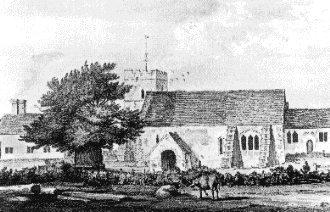
Yew tree at Selborne, Hieronymus Grimm
- 1792: February 27, 1792 – Mr Littleton Etty called. Long tailed titmouse. Crocus’s blowing very much. Winter aconites fade.
- 1791: February 27, 1791 – Snow covers the ground. A large bough broken from the yew-tree, in the church yard, by the snow.
- 1790: February 27, 1790 – Daffodils begin to open. Dr Chandler left us.
- 1788: February 27, 1788 – Dug up the suckers of rose-trees, & planted them in a nursery.
- 1787: February 27, 1787 – On this day my niece Edmd White was delivered of a daughter, who encreases my Nephews, & nieces to the number of 48.
- 1786: February 27, 1786 – Snow shoe-deep. Wrote to Dr Chandler at Nismes.
- 1781: February 27, 1781 – Vast storm. Had the duration of this storm been equal to it’s strength, nothing could have withstood it’s fury. As it was, it did prodigious damage. The tiles were blown from the roof of Newton church with such violence, that shivers from the them broke the windows of the great farm-house at near 30 yards distance. This storm blew the alcove back into the hedge, & threw down the stone dial-post.
- 1779: February 27, 1779 – The gardener begins to mow my Brother’s grass-walks.
- 1775: February 27, 1775 – Crocuss in great splendor.
- 1774: February 27, 1774 – Ewes die in lambing.
- 1773: February 27, 1773 – Sun & clouds, showers & wind.
Notes:
The yew tree in the Selborne churchyard, estimated to be around 1400 years old, blew down in a gale in 1990.
Posted by sydney on Feb 26th, 2009
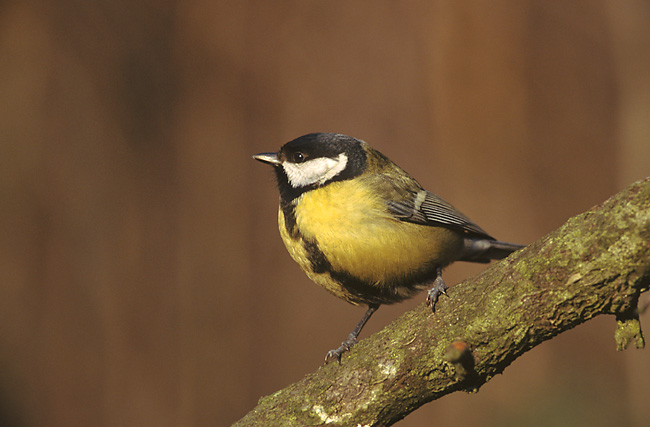
Great Tit, Parus major; photo byMarek Szczepanek
- 1792: February 26, 1792 – Rain in the night. Humble bee. Worms come out on grass plots: a great snail.
- 1791: February 26, 1791 – Deep snow, which damaged & broke my plum-trees, & hedges. This is much the greatest snow that we have seen this year. Some of the deep lanes are hardly passable.
- 1789: February 26, 1789 – Our butcher begins to kill grass-lamb.
- 1783: February 26, 1783 – Venus begins to appear behind the hanger.
- 1780: February 26, 1780 – The ground is covered with snow. People that were abroad early say the cold was very intense. The ground is hard as iron.
- 1779: February 26, 1779 – Pilewort. Summer-like.
- 1775: February 26, 1775 – Viola odorata. Ivy-berries begin to turn black.
- 1774: February 26, 1774 – Land-springs rise. The titmouse, which at this time begins to make two quaint, sharp notes, which some people compare to the whetting of a saw, is the marsh-titmouse. It is the great titmouse which sings those three chearful notes which the country people say sounds like “sit ye down”: they call the bird by that name.
- 1773: February 26, 1773 – Stormy night, with vast rains, fierce wind all day. This storm did considerable damage in many places.
- 1769: February 26, 1769 – Vast rain in the night. Vast aurora borealis.
Walter Johnson’s edition of the journals footnotes the entry on the songs of the marsh- and great-tits with a caution that White has reversed the birds, the great tit being the ‘saw-sharpener’. For comparison their songs are at the top of their respective pages at the RSPB:
Marsh Tit page
Great Tit page
Given the modest snowfall that paralyzed the nation a few weeks ago, one wonders what British Rail would have made of the winters of the Little Ice Age. Snow is now extremely unusual the southern part of the country; let us hope we will continue to see it occasionally in the coming years.
Posted by sydney on Feb 25th, 2009
- 1791: February 25, 1791 – Mr Edmd White took down my Barometer, & cleaned tube, & frame. It had not been meddled with for just 18 years, when my Bror John also took it down.
- 1790: February 25, 1790 – Cabbage sprouts come in. Both the pullets of last summer lay.
- 1775: February 25, 1775 – Honey-bees, & many dipterous insects abound. Frogs croak in ponds. A pair of house-pigeons, which were hatched at Mich: last, now have eggs, & sit. An instance of early fecundity!
- 1768: February 25, 1768 – The missel-thrush, turdus viscivorus major (called in Hants & Sussex the stormcock) sings.
Posted by sydney on Feb 24th, 2009
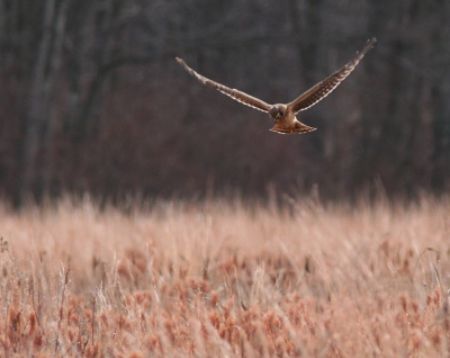
Hen Harrier, lovely image by Jmalik courtesy of Wikipedia.org.
- 1793: February 24, 1793 – Mr White of Newton spring a pheasant in a wheat-stubble, & shot at it; when, notwithstanding the report of the gun, it was immediately pursued by the blue hawk, know by the name of the Hen-harrier, but escaped into some covert. He then spring a second, & a third in the same field, that got away in the same manner; the hawk hovering round him all the while that he was beating the field, conscious no doubt of the game that lurked in the stubble. Hence we may conclude that this bird of prey was rendered very daring, & bold by hunger; & that Hawks cannot always seize their game when they please. We may further observe that they cannot pounce their quarry on the ground, where it might be able to make a stout resistance; since so large a fowl as a pheasant could not but be visible to the piercing eye of an hawk, when hovering over a field. Hence that propensity of cowring & squatting till they are almost trod on, which no doubt was intended as a mode of security; tho’ long rendered destructive to the whole race of Gallinae, by the invention of nets, & guns.
- 1790: February 24, 1790 – Dr. Chandler came.
- 1788: February 24, 1788 – Partridges, & missel-thrushes are paired. Mr & Mrs Clement left us.
- 1784: February 24, 1784 – The laurels, & laurustines are not injured by the severe weather. Snow scarce passable in Newton-lane!
- 1775: February 24, 1775 – Appleshaw river runs.
- 1768: February 24, 1768 – Cucumber plants thrive, and show their claspers.
Posted by sydney on Feb 23rd, 2009
- 1792: February 23, 1792 – Began to drink tea by day light.
- 1791: February 23, 1791 – The farmers are very much behind in their plowings for a spring crop thro’ the wetness of the season.
- 1787: February 23, 1787 – On Feb. 23 the cuckow was heard at Rolle in Switzerland. Rooks build at Faringdon parsonage.
- 1785: February 23, 1785 – Snow-scenes very beautiful. Venus makes a most beautiful appearance.
- 1784: February 23, 1784 – The tops of the blades of wheat are scorched with the frost.
- 1780: February 23, 1780 – Ivy-berries, now near ripe, are coddled with the frost. Heath fires.
- 1779: February 23, 1779 – Drivers use the summer track. Roads dusty.
- 1775: February 23, 1775 – Flocks of hen chaffinches, with some bramblings among them. Saw several empty nutshells with a hole in one side, fix’d in the chinks on the head of a gate-post, as it were in a vice, & pierced as I suppose, by a nuthatch, sitta europaea. Vid: Wllughby’s Ornithol::
- 1774: February 23, 1774 – Several muscae appear Skylarks would sing if the wind would permit.
- 1770: February 23, 1770 – Blue mist. Vulg. called London smoke. Quae: Does this meteorous appearance shew itself on the N:E. side of London when the wind is N:E? If that is the case then that mist cannot proceed from the smoke of the metropolis. This mist has a strong smell, & is supposed to occasion blights. When such mists appear they are usually followed by dry weather. They have somewhat the smell of coal-smoke & therefore are supposed to come from London as they always come to us with a N:E:wind.
- 1768: February 23, 1768 – Great rain. Prodigious floods in Yorkshire, which have swept away all the bridges.
Posted by sydney on Feb 22nd, 2009
Posted by sydney on Feb 21st, 2009
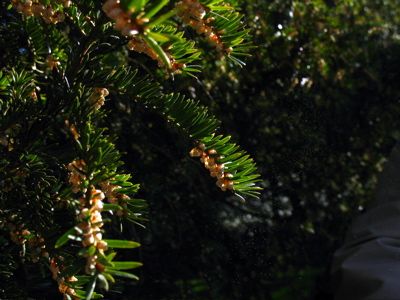
Pollen released from the yew tree in Gilbert White’s garden, 2008.
- 1793: February 21, 1793 – Dug the garden-plot in the orchard, & in the meadow; but the ground was very wet, & heavy.
- 1792: February 21, 1792 – Yellow wagtail appears.
- 1791: February 21, 1791 – Chaffinches destroy the buds in the honey-suckles.
- 1790: February 21, 1790 – Frost, ice, bright, red even, prodigious white dew.
- 1789: February 21, 1789 – Yesterday I fixed some nuts in the chinks of some gate-posts in a part of my outlet where Nuthatches used to haunt: & to day I found that several of them were drilled, & the kernels gone.
- 1788: February 28, 1788 – Full moon. Barom. at Newton 28! no wind.
- 1787: February 21, 1787 – Male yew-trees shed clouds of farina.
- 1783: February 21, 1783 – Ashed the two meadows.
Posted by sydney on Feb 20th, 2009
- 1793: February 20, 1793 – Wheeled much dung into the garden.
- 1792: February 20, 1792 – Snow about four inches deep. 3 Bantam hens lay.
- 1790: February 20, 1790 – As the Surveyor of Gosport-turnpike was mending the road in Rumsdean bottom, he found several Roman coins, one of which was silver. Hence we may conclude that the remarkable entrenchments in that valley, whatever use may have been made of them since, were originally Roman. There is a tradition that they were frequently occupied during the grand rebellion n the time of Charles the first, a period in which many skirmishes happened in these parts, as at Cherriton, Alton, &c. These trenches must have been a post of consequence, because they are on a great road, & between large sloping woods. At the S.W. end of this valley, towards Filmer-hill, in a place called Feather-bed-lane, are three large contiguous barrows which seem to indicate that near the spot some considerable battle must have been fought in former times.
- 1789: February 20, 1789 – Dug a plot of ground for the beans.
- 1786: February 20, 1786 – Bror Henry & his son Gil. came.
- 1783: February 20, 1783 – Men sow pease in their fields, & horse-beans.
- 1779: February 20, 1779 – Field-crickets have opened their holes, & stand in the mouth of them basking in the sun! They do not usually appear ’til March.
- 1774: February 20, 1774 – The high wind last night blowed down a large apple tree in the orchard.
- 1773: February 20, 1773 – Trufles continue to be found in my Bro Henry’s grove of beeches: tho’ the season is near at an end. It is supposed that seven or eight pounds are taken annually at that little spot. My Bro & the trufle-hunter divide them equally between them.
- 1769: February 20, 1769 – Bees gather on the Crocuss.
Posted by sydney on Feb 19th, 2009
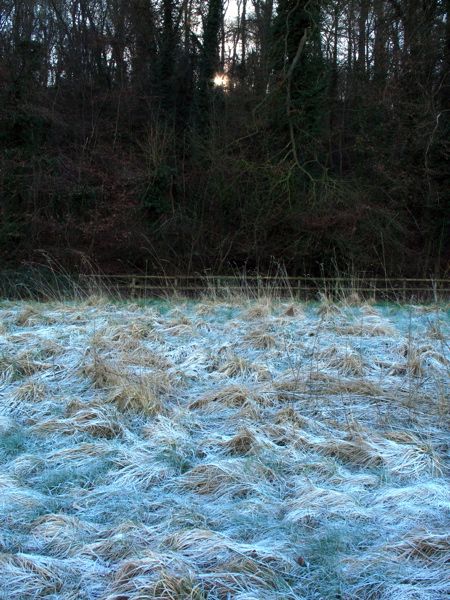
Frost on the mead behind Gilbert White’s house, Selborne.
- 1793: February 19, 1793 – Sowed half a barrel of American Gypsum, which was sent for in the autumn by Bro. Tho., over the fourth ridge of Tim Turner’s wheat, as you reckon from the walk in that field. The powder strewed about two thirds of the ridge from the Ewel S.E. ward.
- 1792: February 19, 1792 – Frost comes within doors.
- 1790: February 19, 1790 – The moon & Venus in the S.W. & Jupiter & Mars in the E. make nightly a charming appearance.
- 1789: February 19, 1789 – A large bank in Burrant garden covered with winter-aconites, which have been there more than 40 years. Missel thrush sings on one of the firs.
- 1788: February 19, 1788 – Bror Thos & Molly White went to London. Mr & Mrs Clemets & two children came, with Zebra, the Nurse-maid.
- 1787: February 19, 1787 – Sowed Baker’s hill, & the great mead with ashes. Crocus’s make a glorious show: bees much out. The air full of insects, & gossamer. Bat appears.
- 1785: February 19, 1785 – Thick ice. Ice in warm chambers. Boys slide. Ground as hard as iron. Snow on the ground.
- 1783: February 19, 1783 – Men busy in plowing for pease. Timothy the tortoise awakes.
- 1782: February 19, 1782 – Thomas kept an account of the rain in my absence.
- 1778: February 19, 1778 – The dry air crisps my plaster in the new parlor.
- 1775: February 19, 1775 – Vast flocks of hen-chaffinches. Honey-bees come forth, & gather on the Crocuss.
- 1774: February 19, 1774 – These great rains retard the preparations for a spring-crop. Grey crows still on the downs.
Notes:
‘Thomas’ was White’s manservant Thomas Hoar, who appears from time to time throughout the journals. Gypsum is still used to improve clay soils. This is earliest date for Timothy the tortoise to emerge from hibernation– probably he went back to sleep!





 Theme Ported to
Theme Ported to